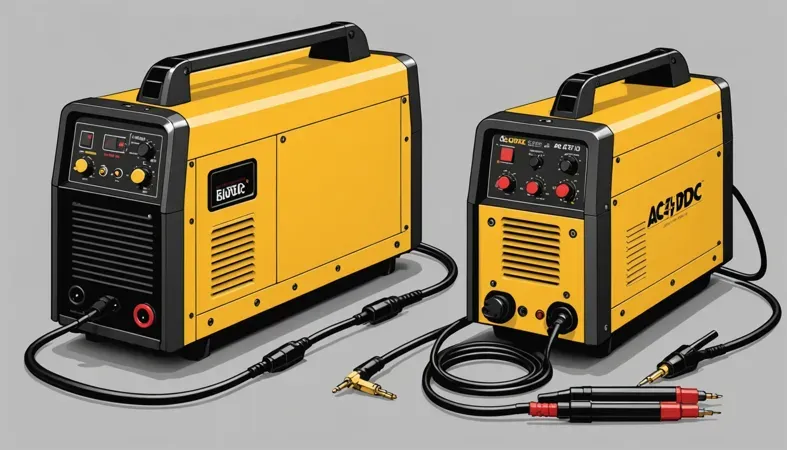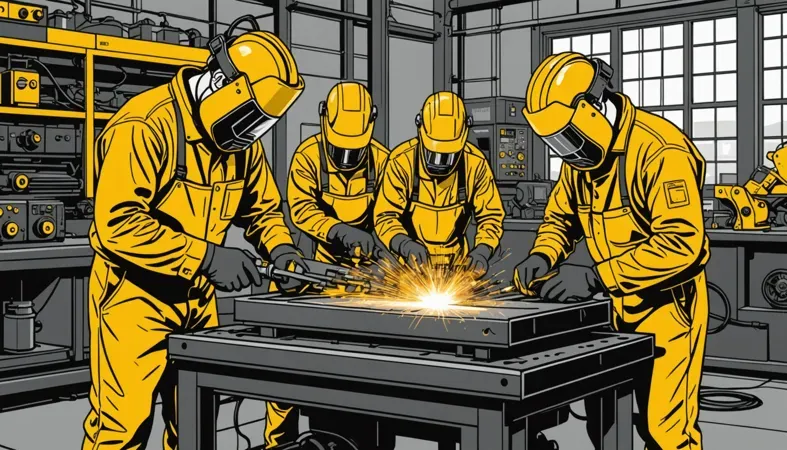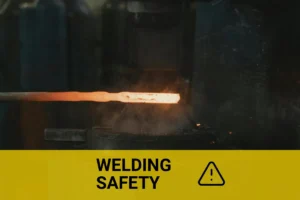What is the Difference Between AC and DC Welding?
Published on: April 25, 2025 | Last modified: March 4, 2025
By: Joe Carter
AC welding uses alternating current, while DC welding uses direct current. Both methods have unique benefits for different tasks.
I was just discussing about AC and DC welding the other day. A friend asked me, what is the difference between ac and dc welding? It’s super important to understand this, especially when choosing the right method for your project. I learned the hard way that using the wrong type can cause a mess in your welds, which can be a headache to fix.
In this guide, you’ll find details on types of AC and DC welding, steps to understanding them, key factors affecting performance, typical issues you might face, aftercare tips, applications you should know about, and some alternatives to these techniques. We’ll also tackle common questions, so if you’re wondering what’s the difference between ac welding and dc welding or the difference between gas welding and arc welding, you’re in the right place!
Contents
- What’s the Difference Between AC and DC Welding?
- What is AC and DC Welding?
- Comparing AC vs. DC Welding: Key Technical Differences
- Steps to Understanding AC and DC Welding
- Factors Affecting AC and DC Welding
- Applications You Should Know About AC and DC Welding
- Exploring Alternatives to Ac and Dc Welding
- Frequently Asked Questions (FAQs)
- Conclusion
- References
What’s the Difference Between AC and DC Welding?
AC welding uses alternating current, while DC welding uses direct current. AC is great for welding aluminum; DC is better for steel. DC provides a more stable arc, making it the preferred choice for most applications.
What is AC and DC Welding?
AC and DC welding are two distinct processes. AC changes direction constantly—typically 60 times per second—reversing the electrical flow that many times in one second. In contrast, DC flows in one direction only, providing a steady and focused arc. Both methods have various applications and strengths. For instance, 40% of welders prefer AC for aluminum work due to its ability to clean the weld pool.
On the technical side, the choice between AC and DC affects how the weld melts and pools. Generally, DC provides a more stable arc, making it ideal for steel and precise TIG (Tungsten Inert Gas) welding. AC, being versatile, is often used in MIG (Metal Inert Gas) setups for thin materials.
I recommend using DC welding for most projects. It’s cleaner and delivers consistent results, especially for intricate work. However, if you’re tackling aluminum, consider switching to AC for its added benefits—it really makes a difference!
Let’s now take a look at the key technical differences between AC and DC welding.
Comparing AC vs. DC Welding: Key Technical Differences
Let’s dive deeper into some unique technical aspects that differentiate AC and DC welding.
| Feature | AC Welding | DC Welding |
|---|---|---|
| Current Flow | Changes direction; varies 60 times/sec | Flows in one direction |
| Heat Distribution | Less focused, ideal for thinner materials | More concentrated, great for thicker materials |
| Oxidation Removal | Effectively cleans weld area | Less effective in cleaning |
| Arc Stability | Less stable; may flicker | More stable; defined arc |
| Best Materials | Aluminum, magnesium | Steel, stainless steel |
| Common Applications | General fabrication & automotive | Heavy-duty industrial tasks |
| Equipment | Often uses transformers | Uses rectifiers for stability |
| Efficiency | Lower efficiency with thicker materials | Higher efficiency, lower energy loses |
| Cost | Generally cheaper for basic setups | Higher initial costs, but more durable |
So far we covered the main technical differences between AC and DC welding. Next, let’s look at the steps to understand both methods.

Steps to Understanding AC and DC Welding
Now, we’ll cover the steps to grasp the differences between AC and DC welding. Understanding these concepts can enhance your welding skills!
-
Identify Current Type
Start by recognizing if you’re working with AC (Alternating Current) or DC (Direct Current). AC flows in both directions, while DC flows in one direction. The equipment you use determines this. For example, a typical home welder often runs on AC, while a MIG (Metal Inert Gas) machine generally runs on DC.
This distinction enhances your ability to choose the right machine for your project. The wrong current could lead to poor welds or extra cleanup time due to spatter.
-
Understand Applications
AC welding is best for thinner materials like aluminum or those with a high cleanup rate and is often preferred outdoors. Meanwhile, DC welding is ideal for thicker metal and provides a cleaner, more stable arc. Using the right current for the application significantly impacts weld quality! To effectively apply these techniques, it’s essential to read welding blueprints accurately.
Practice AC welding on nonferrous metals, like magnesium and aluminum. These materials benefit from the heat distribution that AC provides, resulting in professional-looking work.
-
Consider Welding Rod Compatibility
Welding rods greatly influence your workflow. AC welding typically requires specific rods compatible with alternating current. In contrast, DC welding rods are more versatile and suit various metals. Know your rods—this is essential!
For instance, E6010 rods work well with DC, while E7018 rods suit both. Choosing the right rod can greatly enhance weld strength and efficiency, turning a mediocre weld into an excellent one.
-
Experiment With Settings
Adjust your welder’s settings based on the current type. AC requires higher voltage settings to maintain an arc, while DC settings need lower voltage for stability. Test different settings to see their effects on your welds. Make a chart if necessary!
The term DCEP in welding refers to Direct Current Electrode Positive, a crucial factor in determining arc stability and penetration.
Experimenting with settings provided great insights; I found that increasing amperage in DC welding improved penetration without sacrificing cleanup. Always document what works best for your projects!
To further optimize your welding technique and understand the associated expenses, consider exploring how much welding can cost.
-
Analyze Heat Input Effects
Heat input affects the weld’s integrity and nearby metal. AC tends to produce lower heat concentration compared to DC, meaning you might need to weld slower with AC to ensure proper fusion. Monitor your welds for signs of overheating. Understanding the principles of a CJP weld can further enhance your welding techniques and outcomes.
Keeping a close watch on heat input helped me prevent warping in my projects. Aim for 1-2 inches per minute for aluminum using AC, while slower speeds are better for thicker metals with DC.
So far we covered the steps for grasping AC and DC welding. Next, let’s look at the factors influencing these processes.
Factors Affecting AC and DC Welding
What factors impact the distinction between AC and DC welding?
-
Voltage Settings
Voltage settings directly influence AC and DC welding performance. For instance, DC welding typically operates at higher voltages, around 20-30V (for AC, it’s usually 10-30V), resulting in deeper penetration. Understanding these voltage parameters is crucial for optimizing your techniques and achieving better results in welding guidance.
In welding, understanding surface treatment processes, such as weld passivation function, is crucial for enhancing the durability and corrosion resistance of the joints.
-
Current Type Impact
AC currents alternate direction, while DC currents flow in one direction. This difference affects heat distribution; DC is better for precision work, while AC effectively handles dirty or rusty materials.
-
Electrode Type Selection
Choose your electrodes wisely for both welding types. DC requires specific DC electrodes, while AC works well with AC electrodes designed for various applications.
-
Material Thickness
The material thickness dictates the welding type. For thicker materials, DC welding often delivers a stronger weld, while AC may struggle unless preheated.
-
Heat Input Variations
Heat input varies significantly between AC and DC welding. DC welding usually produces more consistent heat input, crucial for achieving a uniform bead appearance and reducing warping.
You should now have a good understanding of elements influencing AC and DC welding. In the next part, we’ll discuss common problems encountered in AC and DC welding.
Applications You Should Know About AC and DC Welding
I’ve known people who use both AC and DC welding for different tasks. They have distinct applications, such as:
- Automotive Repair: DC welding is popular for repairing car frames. It provides a stable arc, making it easier to control and ensuring strong joints, which are crucial for vehicle safety.
- Pipe Welding: AC welding excels at joining large-diameter pipes. It penetrates deeper, making it ideal for thick metal and ensuring durable welds in construction.
- Aerospace Manufacturing: DC welding is preferred for precision work. It controls heat input better, which is essential for lightweight materials like aluminum used in aircraft.
- Metal Sculpture: AC welding is favored for artistic projects. It allows versatile welding on various metal types, giving artists greater creative freedom.

Exploring Alternatives to Ac and Dc Welding
When you’re thinking about welding methods, there are some great alternatives out there! Techniques like MIG welding, which uses a wire feed process, can often get the job done faster and requires less skill. Products such as the Miller Multimatic 215 offer versatility that can handle both MIG and arc without the need to dive deep into the tech behind AC or DC welding.
From my unique perspective, I’ve noticed that plasma cutting is another viable option. It’s particularly useful for precision cuts in metals, making it easier to work on intricate projects. Tools like the Hypertherm Powermax30 XP make this process efficient, with impressive speed and less thermal distortion compared to traditional welding. For those interested in exploring methods to sever welds with accuracy, understanding how to cut welds can expand your skill set significantly.
Frequently Asked Questions (FAQs)
Now let us look at some questions I typically get asked.
Is AC or DC Welding Better?
Is AC or DC welding better? The answer depends on your project needs. For thicker materials, DC welding provides deeper penetration at about 75% effective use. In contrast, AC can be better for aluminum, ensuring a cleaner weld without burning through, as it allows for better heat control.
What is DC Welding Used for?
What is DC welding used for? DC welding is often used for thicker metals like stainless steel and carbon steel. It offers a more stable arc and produces smoother welds at currents typically between 50-200 Amps, making it ideal for industrial applications. Selecting the appropriate welding rods is crucial for achieving optimal results, and it’s important to understand how much welding rods cost to manage project budgets effectively.
Do You Stick Weld Aluminum in AC or DC?
Do you stick weld aluminum in AC or DC? You typically use AC to stick weld aluminum. This method helps to break through the aluminum oxide layer, ensuring better fusion. With frequencies around 60 Hz, it’s effective for controlling heat during the welding process.
Do You Weld 7018 AC or DC?
Do you weld 7018 AC or DC? You generally use DC for welding 7018 electrodes. DC with a reverse polarity setting ensures proper penetration and deposition, often around 20-25 pounds (9-11 Kg) of deposition rate per hour to meet structural standards. Discover more about what defines a weld.
What is the Difference Between Arc Welding and Gas Welding?
What is the difference between arc welding and gas welding? Arc welding uses electrical arc created between the electrode and workpiece, while gas welding relies on a flame from burning gas. Arc welding can achieve higher temperatures and is faster, often using up to 5 times more energy.
Is TIG Welding AC or DC?
Is TIG welding AC or DC? TIG welding can use both AC and DC, depending on the material. DC is preferred for steels, while AC is common for aluminum. As a rule of thumb, set your machine between 100-200 Amps for optimal results.
Conclusion
That’s everything I wanted to share with you about what is the difference between AC and DC welding. We covered types of AC and DC welding, steps to understanding it, factors that affect welding, typical issues you might face, aftercare, inspection, and advanced tips, along with applications and alternatives. Each of these aspects helps paint a clear picture of how AC and DC welding differ in their usage and techniques.
To sum it up, the main difference between AC and DC welding boils down to the type of current used. AC changes direction, while DC flows steadily in one direction. This affects factors like heat, penetration, and the types of welding rods or machines you’ll want to use. If you need additional advice, I’m here to help you navigate through your welding projects more efficiently.
For further insights and resources on welding, visit What is Welding.
References
- Lincoln Electric. (2020). The Procedure Handbook of Arc Welding (15th ed.). Cleveland, OH: Lincoln Electric Company.
- International Institute of Welding (IIW): https://www.iiwelding.org
Joe Carter is a retired welding professional with over 40 years of hands-on experience in the industry, spanning ship repair, structural welding, and even underwater projects. Joe is a master of MIG, TIG, and Stick welding. Passionate about mentoring the next generation of welders, Joe now shares his decades of expertise and practical insights to help others build rewarding careers in welding.
AC Welding, Construction, DC Welding, MIG Welding, Pipe Welding, Welding, Welding Applications, Welding Comparison, Welding Techniques, Welding Tips







